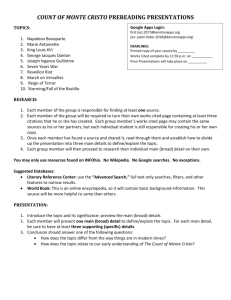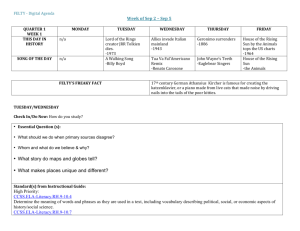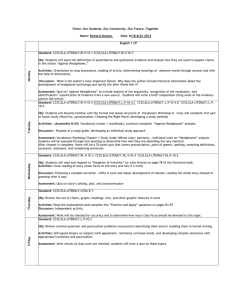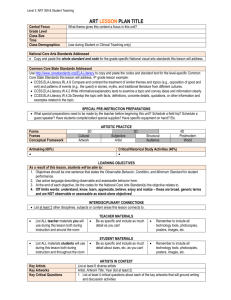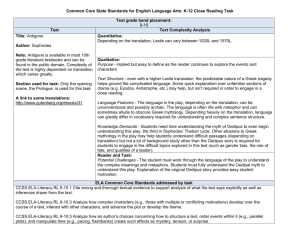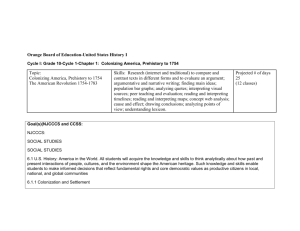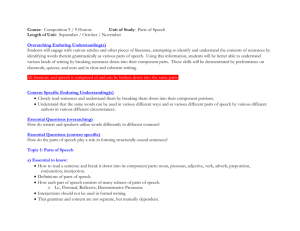Introduction
advertisement
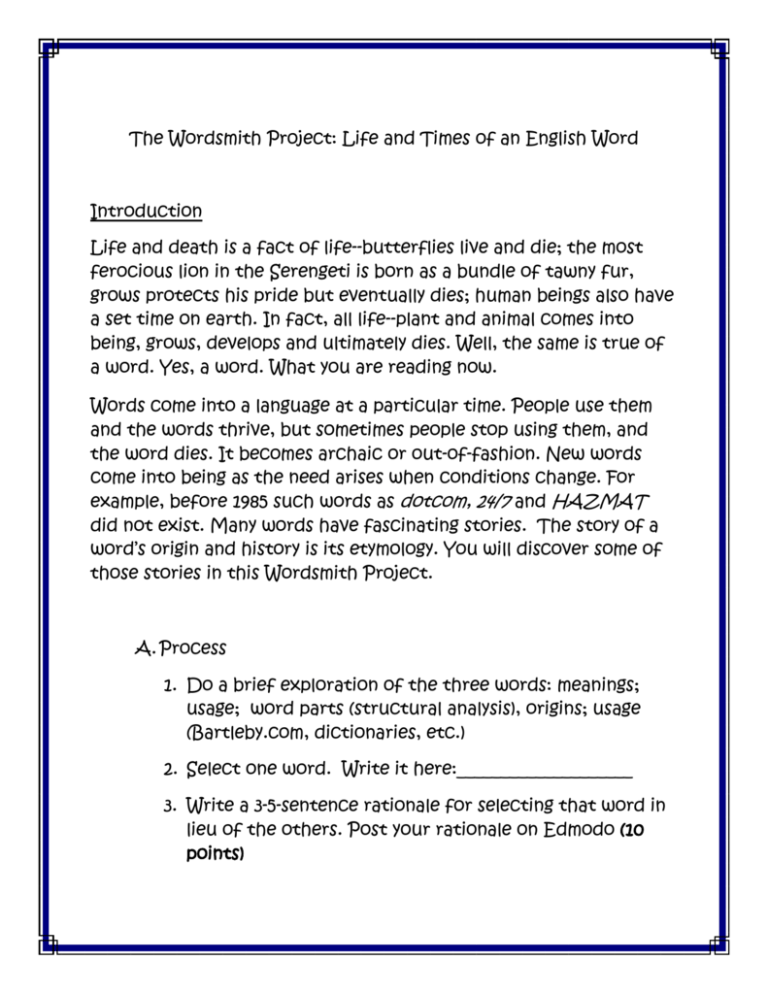
The Wordsmith Project: Life and Times of an English Word Introduction Life and death is a fact of life--butterflies live and die; the most ferocious lion in the Serengeti is born as a bundle of tawny fur, grows protects his pride but eventually dies; human beings also have a set time on earth. In fact, all life--plant and animal comes into being, grows, develops and ultimately dies. Well, the same is true of a word. Yes, a word. What you are reading now. Words come into a language at a particular time. People use them and the words thrive, but sometimes people stop using them, and the word dies. It becomes archaic or out-of-fashion. New words come into being as the need arises when conditions change. For example, before 1985 such words as dotcom, 24/7 and HAZMAT did not exist. Many words have fascinating stories. The story of a word’s origin and history is its etymology. You will discover some of those stories in this Wordsmith Project. A. Process 1. Do a brief exploration of the three words: meanings; usage; word parts (structural analysis), origins; usage (Bartleby.com, dictionaries, etc.) 2. Select one word. Write it here:____________________ 3. Write a 3-5-sentence rationale for selecting that word in lieu of the others. Post your rationale on Edmodo (10 points) 1 4. Sign in to Glogster to see the kind of product you will create. You will find the link to edu.glogster.com in your “The Wordsmith Project” folder on Edmodo. Write your user name here_____________________ Write your password here______________________ 5. Click “Create New Glog.” 6. You may start with a blank canvas or use a published glog as a template that you will use to build yours. 7. Explore Glogs from Glogpedia to get inspiration: http://edu.glogster.com/glogpedia/ 8. You may begin to tinker with Glogster just to see what it can do. B. The Interactive, Multi-media Poster, i.e. Glogster must include the following: (100 points) 1. the word--its various meanings; parts of speech; usage (in meaningful sentences) 2. 1-2 vocabulary graphic organizers (see your Edmodo folder) 3. examples of the words in context--from published texts of different genres (poems, stories, speeches, songs, essays, etc.)--www.Bartleby.Com; www.merriamwebster.com; www.learnthat.org 4. analysis of the word parts -structural analysis (prefix, roots, suffixes) 2 5. examples of the word’s relationship to other words that may be related. 6. etymology of the word (the word’s origin and history) a. video [Find videos at www.learnthat.org- (Type your word in the search area and videos, poems, images, etc. will come up.] 7. audio - depicting the word explicitly as well as implicitly 8. images - depicting the word explicitly as well as implicitly 9. synthesis essay (Bring all of your information together in an interesting and meaningful way.) C. Final: After you have gathered your information, you will write two short essays: 1. synthesis of the information about the word 1-2 typed double spaced pages (50 points) 2. reflection on your work - 1 typed double-spaced page (25 points) [Both essays will be submitted to www.turnitin.com. The synthesis will also be on your Glog.] 3 Vocabulary Acquisition and Use • CCSS.ELA-Literacy.L.9-10.4 Determine or clarify the meaning of unknown and multiple-meaning words and phrases based on grades 9– 10 reading and content, choosing flexibly from a range of strategies. ◦ CCSS.ELA-Literacy.L.9-10.4a Use context (e.g., the overall meaning of a sentence, paragraph, or text; a word’s position or function in a sentence) as a clue to the meaning of a word or phrase. ◦ CCSS.ELA-Literacy.L.9-10.4b Identify and correctly use patterns of word changes that indicate different meanings or parts of speech (e.g., analyze, analysis, analytical; advocate, advocacy). ◦ CCSS.ELA-Literacy.L.9-10.4c Consult general and specialized reference materials (e.g., dictionaries, glossaries, thesauruses), both print and digital, to find the pronunciation of a word or determine or clarify its precise meaning, its part of speech, or its etymology. ◦ CCSS.ELA-Literacy.L.9-10.4d Verify the preliminary determination of the meaning of a word or phrase (e.g., by checking the inferred meaning in context or in a dictionary). • CCSS.ELA-Literacy.L.9-10.5 Demonstrate understanding of figurative language, word relationships, and nuances in word meanings. ◦ CCSS.ELA-Literacy.L.9-10.5a Interpret figures of speech (e.g., euphemism, oxymoron) in context and analyze their role in the text. ◦ CCSS.ELA-Literacy.L.9-10.5b Analyze nuances in the meaning of words with similar denotations. CCSS.ELA-Literacy.L.9-10.6 Acquire and use accurately general academic and domain-specific words and phrases, sufficient for reading, writing, speaking, and listening at the college and career readiness level; demonstrate independence in gathering vocabulary knowledge when considering a word or phrase important to comprehension or expression. 4

